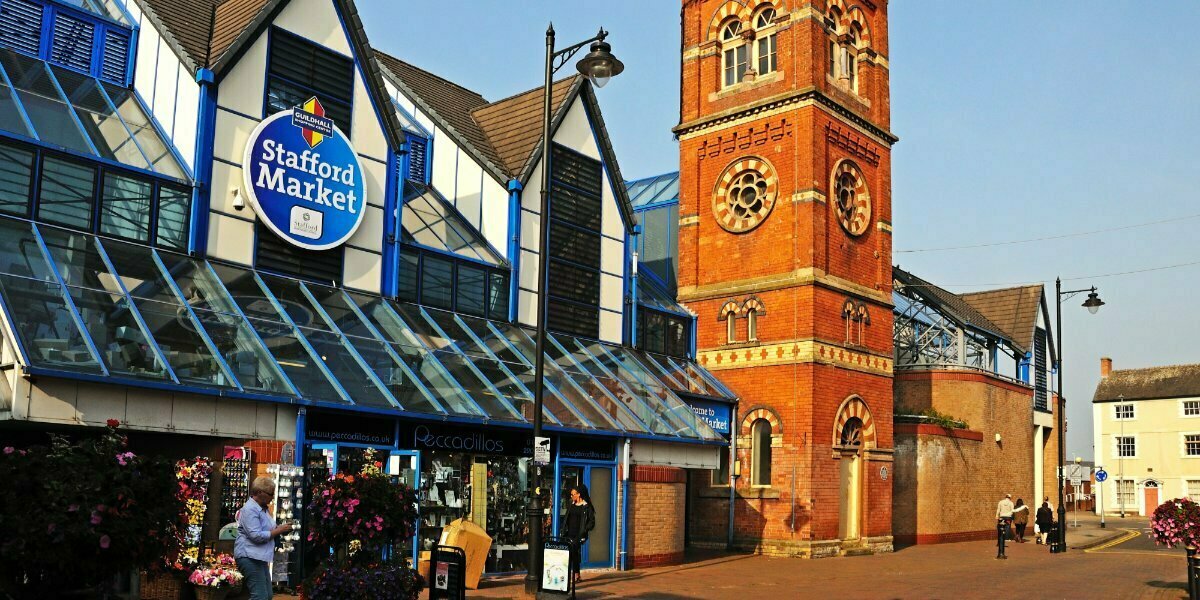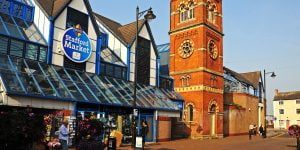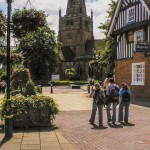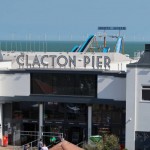
Ever wondered if Stafford would make a nice holiday destination? Find out with Five Minutes Spare.
Stafford can be found in the West Midlands in England. It has a population of about 68,000 people. It is closest to Wolverhampton but lies to the Northwest of Birmingham. Staffordshire, the county in which Stafford lies, is the third-largest county in England.
We wanted to know how Stafford measures up as a staycation destination. Is it a good place to take your family? Will you create good memories here? Would you be better off in Benidorm? Let’s answer some of those questions and find out about the history of this beautiful market town.
The Early Days of Stafford
Stafford takes its name from being known as a landing place. An old English that was called a staithe. The settlement was originally on the gravel bed at a fjord in the River Trent. This would have been a busy crossing point since before bridges we used fjords to cross rivers. A settlement would have grown up around the crossing point, where trade could have been made.
It is believed that the true origins of Stafford occurred in 7oo AD. A Mercian prince named Bertelin founded the town on the peninsula. The original town lies underneath the St Bertelin’s Chapel next to the College Church of St. Mary. This is just outside of the town centre. Other sources say that the tone was founded by Aethelflaed in 913 AD when it was turned into a burh. A burh was a small, rounded, defensible fort set usually on top of a hill. England was scattered with them throughout the era of Danish invasions.
For anyone who has ever watched the Bernard Cromwell series “The Last Kingdom”, You may recognise the name Aethelflaed. She was King Alfred the Great’s daughter who was married off to the king of Mercia. She became a sort of warrior Princess, and many legends were written about her. She was frequently spotted leading her people into battle. During the famines that were intermittent in England at the time, Stafford was turned into an outlet for the distribution of grain. If you can imagine Stafford at the time, it would have been a haven for surrounding villagers fleeing both the Vikings and the shortage of food.
The Burh that Aethelflaed founded here would later become the centre for the creation of Stafford-Ware, Roman-style pottery that was famed throughout England. It also made the centre point for the defence. When the Danes invaded, everyone nearby would flock to the burh and fight them off.
The success of both the burh and the pottery led to Stafford being the home of the royal mint for two hundred years. Remember, this is at a time when England was only just uniting, so Stafford would have been an important city for the Mercian kingdom. It was made a county town as early as the tenth century.
In 1070 AD, William the Conqueror built a castle at Stafford. The north rebelled against Norman rule in 1066, leading to many such buildings being erected throughout the north of England. This helped the invaders keep checks on those that fought back.
During the time of the Domesday survey which was ordered by the Norman invaders, the town of Stafford had 34 households. This is massive for that time. It put Stafford in the largest 40% of all known settlements at the time. There were three known owners listed in town. King William owned the largest portion of land, with 7 pounds of value in one piece and 18 burgesses in another. The Canons of St Mary owned 2 ploughlands, 2 teams to plough time with, 1 furlough of meadows, 1 mill, and was valued at 3 pounds annual revenue. Lastly, the land of Robert of Stafford was worth 3 pounds and 10 shillings. Staffordshire county was formed around this period.
Medieval Stafford
By the year 1200, Stafford had a population of 1000 people. In 1206 it gained its first royal charter. That would have allowed the town to have a market weekly and an annual fair. Natives would have come from all over the county to trade goods here at Stafford, where the land crossed the river. Stafford would have been an annual fair town for about 300 years. This should indicate its importance.
Saint Chad’s church in Stafford was built between the 12th and 13th centuries. At this time there would have been Franciscan Friars in Stafford. They were often known as Greyfriars because of the grey robes that they wore. Although they came to turn to preach, they would only remain there until 1539, when King Henry the eighth eventually dissolved the monasteries.
In 1399, Richard II was shown off in the streets of Stafford as a prisoner of Henry Bolingbroke. Charles I came here as well after the English Civil War began. There was a battle nearby and later, the town would fall to the Parliamentarians and their dastardly ways. The castle only fell after a six-week siege.
Let’s take a short break there and talk about some of the fun things that have happened in Stafford over the years.
Fun facts about Stafford
Whether you live in Stafford or whether you are here for a holiday, we have gathered some of our favourite fun facts together for your appreciation. Read them below and have a giggle.
Fun facts about Stafford:
- The first-ever jar of Marmite was produced by a Staffordshire scientist. Not strictly a Stafford fact, but still. Love it or hate it, marmite is Staffordshire in origins.
- Aethelflaed and her brother, Edward, sought to unite the entirety of England after their father’s death. Alfred the Great was the only English king who did not succumb to the Danes. It was they who welcomed the Danes living in their burhs into England.
- Stafford was producing baking, butchery, grain, pottery, and coins, for Aethelflaed’s army. This indicates that it may have even been a capital at one point.
- Eadric the Wild and the Normans fought at Stafford in 1069. This tremendous battle was what spurred King William on to produce the castle there. The castle was built in wood but was reproduced in stone several times over the years. The 19th-century version used much of the original stonework.
- King James, I was so impressed with Stafford that he nicknamed it ‘Little London’.
There are plenty of other fascinating facts, but we will cover them during our research. For now, let’s return to the history of Stafford from the 16th century onwards.
Stafford from the 1600s
The black death struck this area in the middle of the 1600s, bringing a population reduction of approximately 20%. Between 1645-47, several small villages in the county were stricken particularly badly. Stafford itself had no running water and suffered badly. They also suffered recurring outbreaks from the first recorded in 1348 all the way up to the end of the industrial revolution when piped water was introduced. In 1622, Stafford had a population of 1,550 people. It was a busy market town that would later become a busy clothmaking market town.
John Bradshaw was beheaded in Stafford in 1680. He was scandalously accused of being involved in the ‘Papish Plot’ where important men turned us all into evil Catholics, but he was found innocent after they beheaded him. He remains a testament as to why capital punishment is morally reprehensible.
The next mentions of Stafford are getting towards the Victorian era, with Chetwynd House built in 1746. An infirmary for dispensing medication to the poor was built in 1766, and Stafford even had a theatre in 1792. The Shire Hall was built in 1798.
The 1800s Onwards
By the turn of the century, the population of Stafford was 4,000 people. In 1830 a council of men were elected and given the powers to light, clean, and pave the streets. These commissions eventually led to gas and waterworks, etc. The railway arrived in 1837, opening the cotton trade. Products made in Stafford were distributed all over the UK. Boot and shoemaking, or cobbling, was the main business of the town. The Borough Hall was built in 1877 and a few years after, in 1881, the population was hitting 20,000 people.
Stafford gained an electricity supply in 1895 and the first council houses were built here earlier than most places. While many of us didn’t receive them until returning from the First World War, Stafford already needed to house people in 1901.
Twentieth Century Stafford
Things progressed faster for this large town in the 20th century. Victoria Park was opened and named in 1908. After that, WWI called many of the young men from the town to war, never to return. A Staffordshire Regiment was in Egypt as early as 1882. The Staffordshire Brigade was involved in many of the great battles of the First World War. The memorial added in 1922 details 588 names lost in the first great war.
When the first world war was over, Stafford Council built more council houses, and yet more again after WWII. The shoemaking industry began to die out as demand went into decline. Stafford Guildhall was built in 1934.
The National Memorial Arboretum is in Staffordshire, which is the national tribute for remembrance of the fallen in the British armed forces. Stafford was not a primary target of bombing during the war. Eyewitness statements say that they only recall a single air raid in Stafford, sometime between 1940-2. They remember that the only injury was a girl who sprained her ankle running for the shelter.
In 1978, the Queensway opened and by the turn of the next century, the population was 62,000 people[i]. In 2006 the actual queen visited the town for the 800th anniversary civic celebrations and it celebrated its own 1,100th anniversary in 2013[ii]. The last shoemaking factory closed in 2008.
Modern Stafford has a vibrancy to it that contrasts wildly against the age of the town. It is an enigma of modern retail and dining crossed with heritage, culture, and a feeling of slight repression. If England hadn’t gone on to form, London wouldn’t be the capital of the north. That’s something to think about, the next time you visit.
Famous People from Stafford
There have been lots of famous people that have graced our screens, radio waves, and sports events over the years. Here are some of the more recent ones:
- Storm Constantine – an out there Sci-Fi author from the 80s.
- Carol Ann Duffy, though Scottish, lives here now.
- The comedian Dave Gorman is a Stafford man.
- International poker star Gary Jones
- Fran Healey from Travis has moved here.
- Neil Morrissey from Men Behaving Badly is a Stafford man[iii].
There you have it…. Plenty of people to run into down the pub. Let’s get back to the area and the things you should try to see and do there if you are in town.
The Best Attractions in Stafford
We wouldn’t be Five Minutes Spare if we didn’t point out the best attractions in Stafford for you to peruse. Here are a few of the favourite sites, according to locals.
Historic Sights and Landmarks
Shugborough Estate, found along the River Trent, offers a historic glimpse into a working farm, complete with servant’s quarters. Run by the National Trust, it features a perfectly kept walled garden along with a Georgian Mansion for you to explore. Popular among tourists and those that enjoy high teas, Shugborough Estate is one of Stafford’s best kept secrets.
The Boscobel House is considered an amazing link to Charles II. This is where he stayed when he was making his escape from defeat in the English Civil War. He stayed here in 1651 but was chased by enemy troops. Legend has it that he took shelter hiding in a nearby oak tree, now known as the Royal Oak. Go visit. It’s an old tree.
Let’s not forget Stafford Castle, either. This landmark dominates the higher reaches of the town. It’s in ruins, of course, but you can visit the restored portions. The original castle was completed in 1100 but it has been rebuilt several times since. The recent renovations have tried to retain the original stonework. It is a traditional motte and bailey castle which would have been strategically advantageous, back in the day.
Galleries and Museums
The Tudor style, timber-framed Ancient High House is a museum nowadays. Besides the architectural marvels found on the outside, you can visit to see the scale of it, too. Thought to be the largest Tudor home in the country, this townhouse was built in 1595 for the Dorrington family. It has devoted the interior to remember some of the lives of the people to have graced Stafford over the years. They have an English Civil War room, Georgian exhibits, and more.
There is a lovely little farmhouse museum in Stafford that used to belong to Izaak Walton. His cottage is in the tiny hamlet of Shallowford, just outside the town proper. Izaak Walton wrote the ‘Compleat Angler’ in the days before common people wrote books. His cottage was built in the 17th century and has become a grade II listed building and museum. It is a timber-framed building in the same Tudor style as Ancient High House and has a thatched roof. It’s beautiful.
Sports and Recreation
The local football club is Stafford Rangers FC. The club shouldn’t be confused with the Staffordshire Rangers, who are a different team. They are in the NPL Premier Division. They play at Marston Road Stadium in town.
If you prefer to play golf, you have your choice of clubs within the local area and surrounding countryside. To the northeast, you have Ingestre Park Golf Club. To the southeast, you have the Brocton Hall Golf Club, and there is a Golf Centre at Stafford Castle, too.
Stafford Rugby Club can be found on Blackberry Lane and on Pitchero.
Outdoor Attractions
The Gentleshaw Birds of Prey and Wildlife Centre is the outdoor attraction we all need in our lives. They run a hospital for wounded birds to recover and have flying displays with some of the biggest birds of prey in Britain. The money that you pay for your ticket here will go back towards helping the animals. It’s worth it for the learning experience but it’s a day out that helps.
Those who like gardens must take a walk around Victoria Park in town. This place has phenomenal flower beds with all manner of plant life. They have greenhouses, ponds, fountains, the works. You could spend an afternoon soaking up the scent of the flowers and basking in the beauty here, easily. The Park is on the banks of the River Sow which just makes it more stunning.
Shopping and Retail

Image Caron Badkin/Shutterstock.com
If your preference is for great cities/large towns to shop in, then Stafford covers all the bases. You will find an excellent selection of shops within the town centre. If you are willing to explore further, you will have several shopping malls to choose from. Asides from Queen’s Shopping Park, the best shopping can be found towards Beaconside. There’s the Colonnade Shopping Centre in Eastgate Street and the Riverside Stafford Shopping Centre, too. Best of all though there is still a great market for those who like to shop with a touch of tradition.
What to do with Kids?
A mixture between outdoor attractions and a great thing to do with the kids, the park area at Cannock Chase is lovely for some green space. There is an incorporated play area in Birches Valley where the kids can run free. It’s a great way to get back to nature without having to go too far from town. There’s a Go Ape centre and an orienteering club here to enjoy, too.
Take the kids to the Staffordshire Wildlife Trust’s Wolseley Centre which features a wonderful variety of walks through the area. They have scenic landscapes, a lovely pond, and a giant play barn you can pop the kids into while you have a natter. There’s a restaurant on site too. If you are looking for a similar experience with a play barn and a kiddies village included, try the Amerton Farm attraction, instead. They have animals for petting and feeding, as well.
Where to Eat and Drink in Stafford?
If you are stopping in Stafford for an overnight or longer, you might want to know where the best places to eat are. One of the favoured eastern restaurants in town is Simply Bilash, which serves Bangladeshi food. If your preference is for Thai food, Arroy Thai is a favourite among locals. If your taste in food is more British, check out The Tap Steakhouse.
Other Notable Sights
If you have read this far, it must be because you have tried all the above things to do in Stafford. Here are some other sights and sounds to keep you entertained:
- Visit the Stafford Gatehouse theatre and catch a show. This is the same theatre that was opened back in the 19th century, so there are bound to be a few ghosts in the walls.
- Spend time outdoors playing with the kids at Wildwood Park. They also have a tennis court and a basketball court for you to use.
- Go and see St Chad’s Church, it is quite spectacular on the inside and especially so at Christmas time.
There’s something for everyone in Stafford. It truly does require a few days of exploration to truly appreciate it all.
How to get to Stafford
If you are in London, head north. If not, follow these rough directions and be ready to get a taxi if you must.
By Road
Follow the M6 either north or south.
By Rail
Stafford Train Station is on the Northern Railway Line.
By Air
Birmingham Airport is the nearest one.
By Sea
Stafford is landlocked though does have river access if you are determined to access the town by boat.
Five Minutes Spare Travel
We review lots of towns and cities here for you would-be holidaymakers. Do yourself a staycation solid and head to our Facebook page for updates or read our guides over on our page.
[i] https://localhistories.org/a-timeline-of-stafford/
[ii] https://en.wikipedia.org/wiki/Stafford
[iii] https://en.wikipedia.org/wiki/Category:People_from_Stafford




